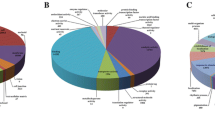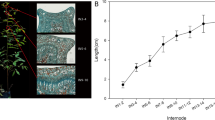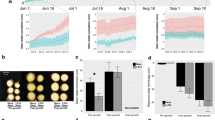Abstract
Branching in long-lived plants can cause scarring at the base and affect wood density, which greatly inhibits wood yield and quality. Eucalyptus urophylla is one of the most important commercial forest tree species in South China, with diverse branch number and branch angles under different genetic backgrounds. However, the main elements and regulatory mechanisms associated with different branching traits in E. urophylla remain unclear. To identify the factors that may influence branching, the transcriptome and metabolome were performed on the shoot apex (SA), lateral shoot apex (LSA), and stem segment at the 5th axillary bud from the shoot apex (S1) in lines ZQUC14 (A) and LDUD26 (B), with A exhibiting a smaller Ba than B. A total of 307.3 million high-quality clean reads and nine hormones were identified from six libraries. Several differentially expressed regulatory factors were identified between the two genotypes of E. urophylla. The Kyoto Encyclopedia of Genes and Genomes pathways were enriched in plant hormone signal transduction, plant hormone biosynthesis and their transport pathways. Furthermore, gene expression pattern analysis identified genes that were significantly downregulated or upregulated in S1 relative to the SA and LSA segments, and the plant hormone signal transduction pathway was constructed to explain branching development. This study clarified the main plant hormones and genes underlying branch numbers and angles of E. urophylla, confirmed that ABA and SA could promote a larger branch angle and smaller branch number, while IAA has an opposite function. Numbers of key candidate genes involved in plant hormone signal transduction were found in the positive regulation of branch formation. These novel findings should aid molecular breeding of branching in Eucalyptus.






Similar content being viewed by others
References
Assuero S, Tognetti J (2010) Tillering regulation by endogenous and environmental factors and its agricultural management. Am J Plant Sci Biotechnol 4:35–48
Bai Y, Chen F, Liu M (2020) Separation of cellulose and lignin from Eucalyptus wood by liquefaction in deep eutectic solvents. BioResources 15(3):6886–6901
Bennett T, Liang Y, Seale M, Ward S, Müller D, Leyser O (2016) Strigolactone regulates shoot development through a core signaling pathway. Biol Open 5(12):1806–1820
Blilou I, Xu J, Wildwater M, Willemsen V, Paponov I, Friml J, Heidstra R, Aida M, Palme K, Scheres B (2005) The PIN auxin efflux facilitator network controls growth and patterning in Arabidopsis roots. Nature 433(7021):39–44
Chen Y, Fan X, Song W, Zhang Y, Xu G (2012) Over-expression of OsPIN2 leads to increased tiller numbers, angle and shorter plant height through suppression of OsLAZY1. Plant Biotechnol J 10(2):139–149
Chen K, Li GJ, Bressan RA, Song CP, Zhu JK, Zhao Y (2020) Abscisic acid dynamics, signaling, and functions in plants. J Integr Plant Biol 62(1):25–54
Clough S, Bent A (1998) Floral dip: a simplified method for Agrobacterium-mediated transformation of Arabidopsis thaliana. Plant J 16(6):735–743
Coutand C, Fournier M, Moulia B (2007) The gravitropic response of poplar trunks: key roles of prestressed wood regulation and the relative kinetics of cambial growth versus wood maturation. Plant Physiol 144:1166–1180
Cox MCH, Benschop JJ, Vreeburg RAM, Wagemaker CAM, Moritz T, Peeters AJM, Voesenek LACJ (2004) The roles of ethylene, auxin, abscisic acid, and gibberellin in the hyponastic growth of submerged Rumex palustris petioles. Plant Physiol 136(2):2948–2960
Davière JM, Achard P (2017) Organ communication: cytokinins on the move. Nat Plants 3(8):1–2
Friml J, Vieten A, Sauer M, Weijers D, Schwarz H, Hamann T, Offringa R, Jürgens G (2003) Efflux-dependent auxin gradients establish the apical-basal axis of Arabidopsis. Nature 426(6963):147–153
Geisler M, Murphy A (2006) The ABC of auxin transport: the role of p-glycoproteins in plant development. FEBS Lett 580(4):1094–1102
Hill JL, Hollender CA (2019) Branching out: new insights into the genetic regulation of shoot architecture in trees. Curr Opin Plant Biol 47:73–80
Hou M, Luo F, Wu D, Zhang X, Lou M, Shen D, Yan M, Mao C, Fan X, Xu G, Zhang Y (2021) OsPIN9, an auxin efflux carrier, is required for the regulation of rice tiller bud outgrowth by ammonium. New Phytol 229(2):935–949
Jin Y, Liu L, Hao X, Harry DE, Zheng Y, Huang T, Huang J (2019) Unravelling the MicroRNA-mediated gene regulation in developing pongamia seeds by high-throughput small RNA profiling. Int J Mol Sci 20(14):3509
Jung H, Lee DK, Choi DY, Kim JK (2015) OsIAA6, a member of the rice Aux/IAA gene family, is involved in drought tolerance and tiller outgrowth. Plant Sci 236:304–312
Kaur S, Cogan NOI, Pembleton LW, Shinozuka M, Savin KW, Materne M, Forster JW (2011) Transcriptome sequencing of lentil based on second-generation technology permits large-scale unigene assembly and SSR marker discovery. BMC Genom 12(1):265
Kepinski S, Leyser O (2005) The F-box protein TIR1 is an auxin receptor. Nature 435(7041):441–445
Kimura M, Kagawa T (2006) Phototropin and light-signaling in phototropism. Curr Opin Plant Biol 9(5):503–508
Kohli R (2019) Applications of ionic liquids in removal of surface contaminants. Developments in surface contamination and cleaning: applications of cleaning techniques. Elsevier, pp 619–680
Lachno DR, Harrison-Murray RS, Audus LJ (1982) The effects of mechanical impedance to growth on the levels of ABA and IAA in root tips of Zea mays L. J Exp Bot 33(5):943–951
Li K, Liang Y, Xing L, Mao J, Liu Z, Dong F, Meng Y, Han M, Zhao C, Bao L, Zhang D (2018) Transcriptome analysis reveals multiple hormones, wounding and sugar signaling pathways mediate adventitious root formation in apple rootstock. Int J Mol Sci 19(8):2201
Liu S, Jin J, Ma J, Yao M, Ma C, Li C, Ding Z, Chen L (2016) Transcriptomic analysis of tea plant responding to drought stress and recovery. PLoS ONE 11(1):e147306
Mao X, Cai T, Wei L (2005) Automated genome annotation and pathway identification using the KEGG Orthology (KO) as a controlled vocabulary. Bioinformatics 21(19):3787–3793
Mashiguchi K, Tanaka K, Sakai T, Sugawara S, Kawaide H, Natsume M, Hanada A, Yaeno T, ShirasuK YH (2011) The main auxin biosynthesis pathway in Arabidopsis. Proc Natl Acad Sci USA 108(45):18512–18517
Mattsson J, Ckurshumova W, Berleth T (2003) Auxin signaling in Arabidopsis leaf vascular development. Plant Physiol 131(3):1327–1339
McSteen P (2009) Hormonal regulation of branching in grasses. Plant Physiol 149(1):46–55
McSteen P (2010) Auxin and monocot development. Cold Spring Harb Perspect Biol 2(3):a001479
Müller D, Waldie T, Miyawaki K, To JP, Melnyk CW, Kieber JJ, Kakimoto T, Leyser O (2015) Cytokinin is required for escape but not release from auxin mediated apical dominance. Plant J 82(5):874–886
Nguyen QTC, Lee SJ, Choi SW, Na YJ, Song MR, Hoang QTN, Sim SY, Kim MS, Kim JI, Soh MS, Kim SY (2019) Arabi-dopsis Raf-like kinase Raf10 is a regulatory component of core ABA signaling. Mol Cells 42:646–660
Ongaro V, Leyser O (2007) Hormonal control of shoot branching. J Exp Bot 59(1):67–74
Palme K, Dovzhenko F, Ditengou F (2006) Auxin transport and gravitational research: perspectives. Protoplasma 229(2–4):175
Parry G, Marchant A, May ST, Swarup R, Swarup K, James N, Graham N, Allen T, Chen Y, Fan X, Song W, Zhang Y, Xu G (2012) Over-expression of OsPIN2 leads to increased tiller numbers, angle and shorter plant height through suppression of OsLAZY1. Plant Biotechnol J 10:139–149
Pepe B, Surata K, Suhartono F, Sipayung M, Purwanto A, Dvorak W (2004) Conservation status of natural populations of Eucalyptus urophylla in Indonesia and international efforts to protect dwindling gene pools. For Genet Resour 31:62–64
R Development Core Team (2020) The R foundation for statistical computing, R version 4.0.2. Austria, Vienna
Saruhashi M, Kumar Ghosh T, Arai K, Ishizaki Y, Hagiwara K, Komatsu K, Shiwa Y, Izumikawa K, Yoshikawa H, Ume-zawa T, Sakata Y, Takezawa D (2015) Plant Raf-like kinase integrates abscisic acid and hyperosmotic stress sig-naling upstream of SNF1-related protein kinase2. Proc Natl Acad Sci USA 112:E6388–E6396
Shimizu-Sato S, Mori H (2001) Control of outgrowth and dormancy in axillary buds. Plant Physiol 127(4):1405–1413
Souza C, Freitas M, Moraes M, Sebbenn A (2011) Estimates of genetic parameters for quantitative traits in open-pollinated families of Eucalyptus urophylla. Floresta 41(4):847–856
Sreenivasulu N, Harshavardhan V, Govind G, Seiler C, Kohli A (2012) Contrapuntal role of ABA: does it mediate stress tolerance or plant growth retardation under long-term drought stress? Gene 506(2):265–273
Storey JD (2003) The positive false discovery rate: a Bayesian interpretation and the q-value. Ann Stat 31(6):2013–2035
Tan X, Calderon-Villalobos L, Sharon M, Zheng C, Robinson C, Estelle M, Zheng N (2007) Mechanism of auxin perception by the TIR1 ubiquitin ligase. Nature 446(7136):640–645
Waldie T, Leyser O (2018) Cytokinin targets auxin transport to promote shoot branching. Plant Physiol 177:803–818
Wang L, Feng Z, Wang X, Wang X, Zhang X (2010) DEGseq: an R package for identifying differentially expressed genes from RNA-seq data. Bioinformatics 26(1):136–138
Wang Y, Li J (2011) Branching in rice. Curr Opin Plant Biol 14(1):94–99
Wang Y, Wang J, Shi B, Yu T, Qi J, Meyerowit EM, Jiao Y (2014) The stem cell niche in leaf axils is established by auxin and cytokinin in Arabidopsis. Plant Cell 26:2055–2067
Wang H, Wang Z, Zhang M, Jia B, Heng W, Ye Z, Zhu L, Xu X (2018) Transcriptome sequencing analysis of two different genotypes of Asian pear reveals potential drought stress genes. Tree Genet Genomes 14(3):40–54
Wang J, Tian Y, Li J, Yang K, Xing S, Han X, Xu D, Wang Y (2019a) Transcriptome sequencing of active buds from Populus deltoides CL. and Populus × zhaiguanheibaiyang reveals phytohormones involved in branching. Genomics 111(4):700–709
Wang P, Zhang S, Qiao J, Sun Q, Shi Q, Cai C, Mo J, Chu Z, Yuan Y, Du X, Miao Y, Zhang X, Cai Y (2019b) Functional analysis of theGbDWARF14 gene associated with branching development in cotton. PeerJ 7:e6901
Xu D, Qi X, Li J, Han X, Wang J, Jiang Y, Tian Y, Wang Y (2017) PzTAC and PzLAZY from a narrow-crown poplar contribute to regulation of branch angles. Plant Physiol Bioch 118:571–578
Yan Y, Zhao N, Tang H, Gong B, Shi Q (2020) Shoot branching regulation and signaling. Plant Growth Regul 92(2):131–140
Yang X, Wei Z, Du Q, Chen J, Wang Q, Quan M, Song Y, Xie J, Zhang D (2015) The genetic regulatory network centered on Pto-Wuschela and its targets involved in wood formation revealed by association studies. Sci Rep 2015:5
Yang H, Xu F, Liao H, Zhang W, Yang X, Xu B, Pan W (2020) Correction to: genome-wide assessment of population structure and genetic diversity of Eucalyptus urophylla based on a multi-species single-nucleotide polymorphism chip analysis. Tree Genet Genomes 16(3):1–11
Young MD, Wakefield MJ, Smyth GK, Oshlack A (2010) Gene ontology analysis for RNA-seq: accounting for selection bias. Genome Biol 11(2):1–12
Zhao Y (2010) Auxin biosynthesis and its role in plant development. Annu Rev Plant Biol 61(1):49–64
Acknowledgements
This study was supported by the National Natural Science Foundation of China (no. 31800568 and 31700590), and the Innovation Project for Forestry Science and Technology in Guangdong (2016KJCX002/2019KJCX003).
Author information
Authors and Affiliations
Contributions
HY and XY designed the research. HL, WZ, XC and BX conducted the experiments. The data were analyzed by FX and WP. All authors read and provided helpful discussion, and approved the final version.
Corresponding author
Ethics declarations
Conflict of interests
The authors declare that they have no competing interests.
Ethical standards
This article does not contain any studies with human participants or animals performed by any of the authors.
Additional information
Communicated by Stefan Hohmann.
Publisher's Note
Springer Nature remains neutral with regard to jurisdictional claims in published maps and institutional affiliations.
Supplementary Information
Below is the link to the electronic supplementary material.
Rights and permissions
About this article
Cite this article
Yang, H., Xu, F., Liao, H. et al. Transcriptome and metabolite analysis related to branch development in two genotypes of Eucalyptus urophylla. Mol Genet Genomics 296, 1071–1083 (2021). https://doi.org/10.1007/s00438-021-01803-z
Received:
Accepted:
Published:
Issue Date:
DOI: https://doi.org/10.1007/s00438-021-01803-z




